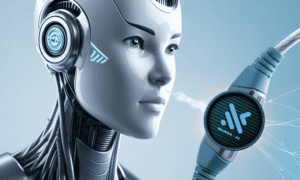Space is the final frontier. As humans continue to explore the vastness of our universe, one thing becomes abundantly clear: we need a little help from our friends in artificial intelligence (AI). The days of relying solely on human astronauts to navigate and execute complex space missions are gradually giving way to a new era – an era where AI takes center stage in advancing technological capabilities beyond anything we could have ever imagined. Join us as we delve into this exciting future, where harnessing the power of artificial intelligence propels us further into uncharted territories of space exploration.
Introduction to Artificial Intelligence in Space
As artificial intelligence (AI) technology continues to develop and become more sophisticated, there is a growing interest in its potential applications in space exploration and related fields. AI has the potential to revolutionize space missions by providing new ways to collect and process data, as well as improve communication between humans and machines.
In recent years, AI technology has been used in a variety of space-related applications such as satellite image analysis, target identification, and spacecraft navigation. As AI technology continues to evolve, it is expected that even more innovative and impactful applications will be developed that can further support and enhance space exploration efforts.
The use of AI in space missions brings with it a number of advantages and benefits. One key advantage is the ability of AI systems to rapidly process large amounts of data. This is particularly useful for tasks such as analyzing images or identifying patterns in sensor data. In addition, AI can also be used to help plan mission trajectories and optimize spacecraft operations.
Another major benefit of AI is its ability to improve communication between humans and machines. For example, natural language processing (NLP) techniques can be used to automatically translate messages from one language to another. This could be used to facilitate communication between ground control teams and astronauts on long-duration missions. Additionally, AI could be used to develop new methods of human-machine interaction that are more intuitive and efficient than current approaches.
The use of artificial intelligence in space exploration offers a number of potential benefits and is sure to be a major factor in future missions. It is important that the technology is developed in an ethical manner, taking into account the safety of human astronauts and complicated legal frameworks regarding access to space. With careful consideration and planning, AI could revolutionize space exploration and open up new possibilities for humanity.
Benefits of AI in Deep Space Exploration
One of the primary benefits of artificial intelligence in space exploration is the ability to process and make decisions based on large amounts of data. For example, AI can be used to analyze data collected by sensors and satellites to identify patterns and trends that human analysts might miss. Additionally, AI can be used to develop plans for future space missions by identifying potential risks and opportunities.
AI also has the potential to improve the safety of space missions by providing early warnings of hazards and helping to develop contingency plans. For example, AI could be used to monitor environmental conditions on other planets or in deep space and provide warnings of approaching storms or other dangers. Additionally, AI could be used to autonomously operate vehicles or robots, reducing the risk to human astronauts.
AI can help reduce the cost of space exploration by increasing the efficiency of mission planning and execution. For example, AI-assisted planning could shorten the duration of missions by identifying optimal trajectories and targets. Additionally, AI-operated robots could perform tasks such as repairs or inspection without needing supervision from human astronauts, which would reduces overall mission costs.
The Applications of AI for Astronauts and Human Pilots
AI is revolutionizing the field of space exploration and astronauts are beginning to rely on artificial intelligence (AI) for various tasks. AI can help with orientation and control in zero-gravity environments, assist with decision-making during long-term missions, and even act as a crew member on future space missions. Below we take a more detailed look at how AI is being used by astronauts and human pilots today.
Orientation and control: One of the main advantages of using AI in space is its ability to help astronauts with orientation and control. In zero-gravity environments, it can be difficult to keep track of one’s surroundings and assess the situation correctly. AI can act as a second set of eyes for astronauts, providing them with real-time information about their surroundings. It can also be used to control robotic arms or legs, giving astronauts an extra level of control when they need it most.
Assistance with decision-making: Another key area where AI can be extremely useful for astronauts is in assisting with decision-making during long-term missions. With its ability to process large amounts of data quickly, AI can help identify potential problems or hazards that the astronaut might not be aware of. By flagging these issues early, AI can help prevent them from becoming serious problems later on.
Crew member on future missions: AI could also play an important role as a crew member on future space missions. With its advanced reasoning abilities, AI could be responsible for carrying out tasks such as monitoring systems, running experiments or even carrying out repairs. This would free up the astronauts to focus on mission-critical activities and provide an extra level of safety.
AI for airliners: AI is also beginning to be used by human pilots in the commercial aviation sector. AI is being used to help with mid-flight decision making and route optimization. By providing data analysis and trend predictions, AI can help pilots make informed decisions on the best course of action in relation to weather, fuel consumption, air traffic control and crew scheduling. Additionally, AI can act as a secondary pilot, monitoring regular operations in case of emergencies or system malfunctions.
Challenges of AI in Space Missions and Strategies to Overcome Them
AI presents a number of challenges for space missions. First, the data collected by space-based sensors is often noisy and incomplete, making it difficult to train AI algorithms. Second, space missions often have very strict requirements on power and weight, making it difficult to use conventional AI hardware. The environment of space is extremely hostile, with high levels of radiation and temperature extremes that can damage delicate electronic components.
To overcome these challenges, NASA is investing in a number of different strategies. One is to develop new AI hardware that is specifically designed for use in space. This includes specialised radiation-hardened chips and extreme-temperature tolerant materials. Another strategy is to make better use of data from other sources, such as ground-based telescopes and satellites, to supplement the data collected by space-based sensors. NASA is also working on developing new methods for training AI algorithms that are more robust to noise and incompleteness.
How the USE of AI Could Shape Future Explorations
The use of artificial intelligence (AI) in space exploration could lead to a number of significant advances. For example, AI could be used to plan and execute missions more efficiently, as well as monitor and analyze data collected by spacecraft. Additionally, AI could help identify potential hazards during missions and enable spacecraft to autonomously avoid these dangers. Moreover, the use of AI might one day allow for the development of fully autonomous robotic spacecraft that could explore the universe without human intervention. Ultimately, the use of AI in space exploration hold the promise of immensely expanding our knowledge of the cosmos and our place within it.
Latest Missions Utilizing Artificial Intelligence
The use of artificial intelligence (AI) in space missions is becoming more and more common as the technology continues to develop. There are a number of different ways that AI can be used in space missions, from helping to control spacecraft to assisting with data analysis.
One of the most common ways that AI is being used in space missions is for controlling spacecraft. This is because AI can provide a level of flexibility and adaptability that is not possible with traditional control systems. AI-powered spacecraft can make decisions on their own, which can be helpful when things do not go according to plan. For example, if a spacecraft encounters an unexpected obstacle, an AI system can quickly identify the best way to avoid it.
Another way that AI is being used in space missions is for data analysis. There is a vast amount of data generated by space missions, and it can be difficult for human scientists to make sense of it all. However, AI systems are well-suited for this task as they can quickly sift through large amounts of data and identify patterns or trends. This information can then be used to help plan future missions or make adjustments to current ones.
The use of AI in space missions is growing rapidly as the technology continues to mature. It offers a number of benefits over traditional approaches, and we are only beginning to scratch the surface of what is possible.
Conclusion
Artificial intelligence, when implemented correctly, can be a powerful tool for space missions. In this article, we explored different areas in which AI could play an important role from navigation to communication and beyond. Not only is it possible today but its advancement has already started an evolution that will shape the design of future spacecrafts and other exploration initiatives. Although there are many challenges yet to overcome while integrating AI into our space programs, the potential benefits make it worthwhile to continue investing resources into furthering research on the topic.































